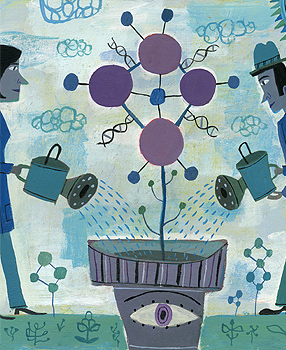SUMMER 2009 CONTENTS
Home
In the crosshairs
Basic science under the microscope
Harkin’s hope
Re-creating America as a wellness society
Anatomy of an experiment
Chasing down the cell’s gatekeepers
The Catalysts
How the farm became a giant force in biology
Crossovers
Learning to speak “doctor”
The science pages
Scientists built the web. Do they love web 2.0?
Opening doors
Finding funding for graduate students in basic science


Opening doors
Finding funding for graduate students in basic science
Illustration by Calef Brown
A graduate student in applied physics, Aaron Streets already spends most of his weekends in the lab. But one Saturday last April was different — instead of performing his usual experiments on protein crystals, Streets spent the day teaching local entrepreneurs and Stanford alumni about his research.
The first-ever biosciences “lab crawl” was designed to tackle an important but little-known problem in basic science research: the challenge of funding graduate students.
“It’s a major issue,” says Andrew Fire, PhD, professor of pathology and winner of the 2006 Nobel Prize in Physiology or Medicine. “At this point there are many really creative and productive labs that simply can’t take graduate students because it’s too expensive.”
Students in Stanford’s graduate studies program in the biosciences take an average of six years to complete a PhD and require a total of about $370,000 for tuition and living expenses. Unless students have outside funding, grants to faculty and departments cover their tuition and stipend.
The National Institutes of Health is the biggest source of external support for these graduate students, but a new cap on NIH tuition reimbursement has made the funding challenge greater than ever. The cap, instituted in 2007, has increased the cost of graduate training to universities by more than 40 percent nationwide, according to the Council on Governmental Relations, an association of research universities. Before the cap, universities were paying $70 million a year for graduate tuition. Now they pay $100 million.
Some universities waive tuition, but that means less money for educational expenses. Relying on federal funding also limits the types of projects graduate students can work on. “Grants are clearly a key part of the Stanford research effort,” Fire says, “but the best and most creative part has always been the work initiated by students exploring in their own direction.”
To secure independent funding, Stanford hopes to do what some fundraising pros consider next to impossible: Inspire private donors to support graduate students training to be basic scientists.
Most private donations to the School of Medicine come from grateful patients who have developed close ties with the faculty who treat them, says Denise Ellestad, senior director of development at the medical school. But basic science faculty and students don’t have grateful patients. “Some of the things they’ve done have had tremendous impact for patients,” Ellestad says, “but their contributions are farther up the pipeline, so they’re less visible to potential donors.”
That’s where events like the biosciences “lab crawl” come in. On April 18 and June 3, graduate students and faculty escorted small groups of potential donors from lab to lab, demonstrating their research and running hands-on demonstrations.
Streets and his labmates showed off some of the latest inventions from their lab, including a device called “laser tweezers” that makes it possible to isolate a single cell from a colony of bacteria to look at its genetic material. Lab crawl participants had the chance to try out the tweezers by grabbing a single bacterial cell and manipulating it under the microscope.
“The graduate students were wonderful,” says participant Jerry Burnett, chairman of Avistar Communications in San Mateo. “And by going from just reading about science to actually seeing the experiments, equipment and techniques, you get a glimpse into the process and possibilities of basic science. I’d go back every week if they had one.”
Although it’s too early to tell whether the lab crawl will generate donations, Stanford fundraisers consider the event a success. “Donors got to pipette shoulder to shoulder with grad students at the microscope,” Ellestad says. “It’s those personal interactions that make the biggest difference.”— Hadley Leggett

